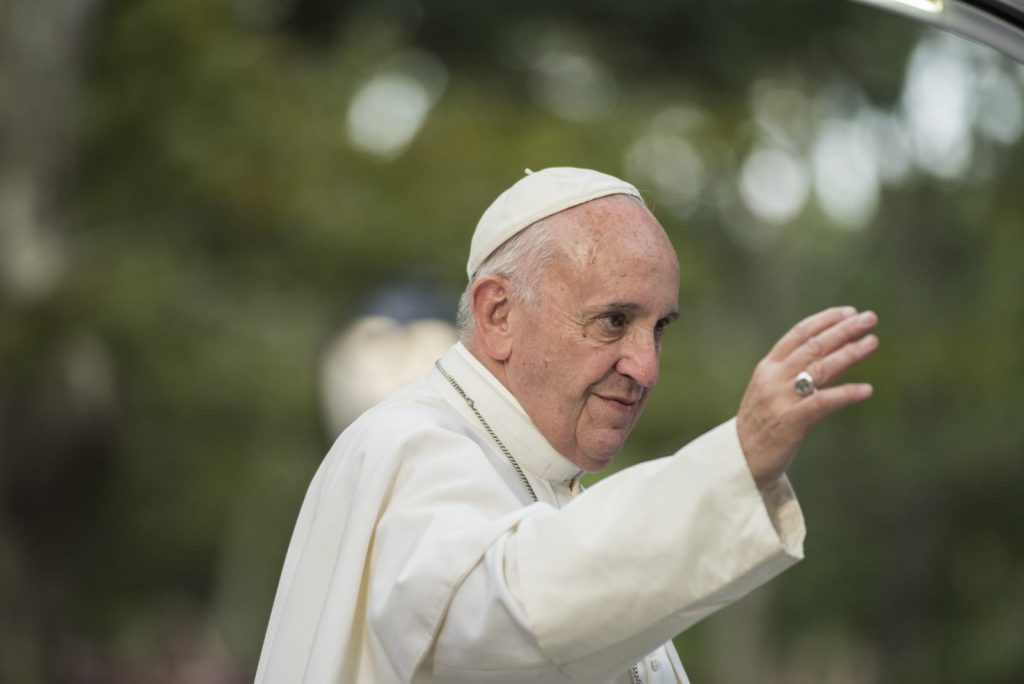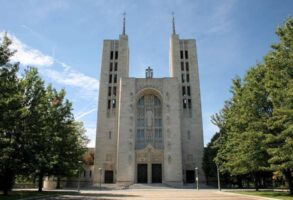
Published March 29, 2018
REVIEWED IN THIS ARTICLE: To Change the Church, by Ross Douthat
Pope Francis’s pontificate did not begin with doctrinal controversy. It began with the appearance of an amiable Argentine on the balcony of St. Peter’s and endearing stories about a pope who rides the bus and pays his own hotel bills. His papacy seemed to present an opportunity to draw together two competing visions of Catholicism’s proper disposition toward the contemporary world. At the risk of oversimplifying, the first vision wants the church to be more open and democratic. The other has more traditional and hierarchical emphases. Each, at its best, represents a legitimate, orthodox vision of Catholicism. Each, at its worst, flirts with dissent, rupture, and even schism. Like brothers who sometimes quarrel, each tends to be wary of the other. As inadequate as the political terms “liberal” and “conservative” are to this purpose, they can work as shorthand: If Francis’s immediate predecessors were more or less conservative, the newly elected pope appeared to be more or less a liberal, but well within the bounds of Catholic orthodoxy.

Five years later, these longstanding divisions have not been resolved; in fact, they have become so aggravated that the worst version of each side is often on display. Ross Douthat, in his new book, To Change the Church, looks at Francis’s pontificate, examining both the missed opportunities and the ongoing search for a new, stable synthesis. In even admitting the promise of this pontificate, Douthat is showing more good will and sense than many of the pope’s critics do. And Douthat is certainly himself a critic, if a thoughtful and pious one. Regular readers of his New York Times column will not be surprised to learn that Douthat has written the most balanced and least polemical of the recent critiques of this pontificate. Pope Francis tends to elicit strong reactions from commentators, and Douthat offers if not a dispassionate assessment then at least one that takes seriously the limits of assessing the legacy of any pontificate after just five years.
To help his readers understand this papacy’s initial promise and the controversies it has engendered, Douthat begins by walking them through the last few decades of Catholic history. In the years following the Second Vatican Council (1962-65), all manner of weirdness (and worse) wafted into the church—some of it revealing how fragile and vulnerable the church had already become by the time the council began. A manic spirit of experimentation and worldliness spread through the church, eventually exhausting itself in jaded cynicism. Seminaries emptied; religious orders imploded. Catholic catechesis and sacramental discipline entered a long slump. This was when the sexual abuse of minors by Catholic clergy was at its diabolical peak, although most of it wouldn’t come to light for many years.
In 1978, Pope John Paul II was elected. He set about restoring order after a decade of dissolution. Like a trauma doctor presented with a critical case, the young pope set about stabilizing the patient. Bleeding was stanched, bones were set, splints and casts and braces were applied. It took decades, but by the time John Paul’s successor, Pope Benedict XVI, abdicated in 2013, the patient appeared stable. There were crises, to be sure—the long-overdue reckoning on the sexual-abuse problem, notably—but the church had survived the worst of its internal injuries.
Sooner or later, splints and casts and braces have to come off. Limbs that haven’t borne weight need strengthening and exercise. Joints that have grown stiff need to become flexible and limber again. If one is to become healthy, stability must sooner or later give way to a new stage of vulnerability. But if one proceeds too quickly and incautiously, old wounds can be reopened.
Enter Pope Francis. From the beginning, it was clear that his style was earthier, less formal, than that of his predecessors, especially the professorial Pope Benedict. That’s part of Francis’s charm. If the Argentine pope’s politics have more of a Peronist flavor, it’s also true that he is hardly the first bishop of Rome to warn against consumerism and the exploitation of creation or to remind the affluent of their obligations to the poor, the sick, the migrants. As Douthat points out, such remarks mostly seemed to threaten “a particularly American marriage of conservative Catholicism and free market ideology, which given the state of conservative politics in America perhaps deserved a period of papal challenge and self-critique.” A pope with a moderately leftist view of the world might not be such a bad thing after 35 years of relative conservatism. As the Italians say, “A fat pope follows a thin one.”
Beneath all this, Pope Francis still clearly shared his predecessors’ conviction that the church exists to preach the gospel to a world desperately in need of it. In other words, he knew that for the church to be what she must be, she couldn’t spend all her efforts looking inward. Chronic dysfunction and corruption in the Vatican curia, new waves of sex-abuse scandals in Europe, and the long war of attrition between the church and secular culture—especially on issues like same-sex marriage and abortion—had left the Catholic church in a decidedly defensive posture. An overly defensive church can easily forget that it has a mission.
And so Pope Francis’s early priorities reflected a refreshing reemphasis on the church’s primary mission. He wanted a church that is less self-referential, less closed in on itself; he wanted a church that leads with tenderness rather than judgment; he preferred a church that is “bruised, hurting, and dirty” from having been in the streets over a church that is “unhealthy from being confined and from clinging to its own security”; he wanted shepherds “who smell like their sheep”; he said he wanted a church “that is poor and for the poor.” He envisioned the church as a field hospital, where those shattered by a “throwaway culture” can receive mercy’s balm. In all of this, Pope Francis sought to move the church toward the very same goal his predecessors had desired: a “new evangelization” for the world and a “new springtime” for Catholicism.
* *
The decisive shift in Francis’s pontificate toward doctrinal brinksmanship arose, it seems, not out of deep ideological commitment to theological liberalism, but from his genuine fervor for bringing mercy and compassion to the fore. On the question of communion for the divorced and remarried, the pope looked to aging German theologians whose pastoral conclusions—if not the Hegelian theology used to reach those conclusions—enthralled him, ultimately convincing him to push the doctrinal envelope in ways very few of his predecessors ever have and in ways his most immediate predecessors had rejected outright. In doing so, Douthat writes, the pope threw away a golden opportunity
by wedding his economic populism instead to . . . the moral theology of the 1970s, making enemies of conservatives (African, American, and more) who might have been open to his social gospel, treating economic moralism not as a complement to personal moralism but as a substitute . . . and driving the church not toward synthesis but toward crisis.
The “marriage problem,” as Douthat calls it, was the focus of two synods (large meetings of bishops) that convened in Rome in 2014 and 2015. The synods were supposed to highlight the more collegial, less hierarchical style of governance Pope Francis wished to exemplify, but they instead became moments of intense controversy. Douthat covers the machinations and politicking at these synods in great detail, but what matters is that the pope and his handpicked managers went to great lengths to achieve the outcome they preferred: some version of the German proposal to allow communion for the divorced and remarried. In the end, they were frustrated, but the fight exposed and solidified the deep divisions between those opposed to such changes and those in favor.
It’s difficult to overstate the importance of this disagreement for Francis’s papacy and for the future of the church: Supporters of opening a new path to communion for the divorced and remarried claimed the matter was simply a question of “updating” and “reforming” church discipline in certain limited circumstances; opponents insisted that the proposed changes would create a rupture with the settled doctrine of the church. But the changes Francis and his allies hoped to institute stretched the limits of what is doctrinally possible, even for a pope. The question of communion for the divorced and remarried has profound implications for nearly every aspect of theology. Standing in the way of the permissive, pastoral approach Pope Francis seemed to favor are the explicit teachings of numerous popes and ecumenical councils, two millennia of Catholic Christianity, and, above all, the unambiguous words of Jesus himself: “Whoever divorces his wife and marries another commits adultery.” When two baptized Catholics marry, nothing except death, not even the pope himself, can dissolve that union. And so long as you’re married to one person, you can’t go starting a new marriage with someone else. Adultery, like any other serious sin, precludes a Catholic from receiving communion until that sin is confessed and absolved.
The reformers insisted their proposals would not change any of that. But they could not explain how their plan—to permit people who, as far as the church was concerned, were not married to receive communion while still living together as husband and wife—did not contradict in practice what the church clearly taught in principle. Something had to give: Christ’s own words on the indissolubility of marriage and the nature of adultery; or St. Paul’s teaching about the need to receive the Eucharist worthily, and thus not in a state of serious sin; or the church’s perennial teaching that real repentance is required to receive absolution in confession; or her infallible teaching that the commandments are never impossible to keep, no matter how trying the circumstances.
In early 2016, Pope Francis published the longest papal document in history, an apostolic exhortation called Amoris Laetitia, which in Douthat’s words “yearned in the direction of changing the church’s rules for communion . . . its logic suggested that such a change was reasonable and desirable. Yet [Pope Francis] never said so directly.” In the document, the most fraught and contentious question of the synods—the source of so much friction, drama, and division—was reduced to a single, studiously ambiguous footnote. When it came to the church’s pastoral care for those in irregular marital situations, the pope noted, “In certain cases, this can include the help of the sacraments.”
Which sacraments? Under which conditions? Was this a restatement of prior teaching or a reversal? The document didn’t say. Pope Francis apparently settled on a do-what-I-mean-not-what-I-say approach. He may have hoped to leave the matter ambiguous enough to prevent a doctrinal crisis while still allowing room for more permissive pastoral practices. And that approach might have succeeded, if not for the fact that different bishops around the world began interpreting the ambiguous footnote in radically different ways. Even those who praised the new teaching couldn’t agree on just what was being taught. The sacramental discipline and moral teaching of the Catholic church began to divide along national and diocesan boundaries almost immediately.
In Poland, for example, the bishops reiterated existing teaching that the divorced and remarried could not receive communion. Other bishops, hoping to use the wiggle room created by Amoris Laetitia to push for far more radical changes, got straight to work. In Germany, where declining to pay the church tax gets you excommunicated and where pews are empty but coffers are overflowing, the bishops have pushed for opening communion to certain non-Catholics and have floated the idea of blessing same-sex partnerships.
In light of the more radical interpretations of the pope’s teaching, more traditionalist prelates have made official requests for the pope to clarify just what it is supposed to mean. These requests have been ostentatiously ignored, and the inquirers treated like ecclesiastical pariahs. As the gaps in teaching and practice from diocese to diocese have widened, it has become clear that something more than the pope’s wink-wink-nudge-nudge approach is required. The pope retroactively elevated to magisterial status a private letter he had written to the bishops of Buenos Aires praising them for their guidelines for interpreting and implementing Amoris Laetitia and claiming “no other interpretations are possible.” This includes—presumably—the Argentine bishops’ claim that in certain circumstances, it is “not feasible” to not commit adultery and that in such cases folks might be able to receive communion. The pope could not be less interested in explaining how this interpretation squares with the Council of Trent’s teaching that following the commandments is never impossible.
So far, the debates over Amoris Laetitia have involved mostly bishops, priests, and theologians; Pope Francis has left the defense of his ambiguous magisterium to a coterie of advisers and subordinates who enjoy the deference afforded them by their proximity to him. Meanwhile, the acrimony of the marriage debate seems to have surprised the pope and pushed him away from consensus-seeking and more solidly toward the reform-minded prelates who supported him through the synods and who are now eager to cement Francis’s legacy, lest it all be washed away in the next conclave.
As Douthat notes, looking back at the last several years, “Francis’s apologists knew very well that they weren’t just defending simple pastoral flexibility against the rigor of conservatives. Flexibility they surely wanted, but there was also clearly a more revolutionary vision implied and waiting underneath.” How far they will be able to press that revolution, and whether Pope Francis will eventually try to slow the revolution being waged in his name, remain open questions.
* *
There is little sign that Catholics in the pews on Sunday—or not in the pews, as the case may be—are much concerned with the debates over Amoris Laetitia. But the stakes are too high and the interpretations of its teachings too diverse for the current situation to remain stable for long. The church can tolerate, and for a long time, a great deal of diversity in pastoral practice. But diversity in principle? Deep disagreement about the moral law, the sacraments, and the limits of doctrine itself? Divisions on issues so fundamental have a way of leading to deep and lasting damage to the unity and credibility of the church—to schism and worse. On this point, Douthat takes a pessimistic view:
The church has broken in the past, not once but many times, over tensions and issues that did not cut as deeply as the questions that undergird today’s Catholic debates. Other communities have divided very recently over precisely the issues that the pope has pressed to the front of Catholic debates. And for good reason: Because these issues, while superficially “just” about sexuality or church discipline, actually cut very deep—to the very bones of Christianity, the very words of Jesus Christ.
Toward the end of his book, Douthat turns to history and attempts some synthesizing of his own, trying to find some precedent for or analogue to the season of division in which the church finds itself. He focuses on two past controversies—between Athanasians and Arians in the 7th century and between Jansenists and Jesuits in the 17th—as templates for thinking about how the current crisis might resolve itself in the long term. Applying the lessons of these episodes, Douthat guides the reader through various permutations, balancing one interpretive narrative with another and offering likely, or at least possible, scenarios.
To his credit, Douthat is willing to entertain the idea that he is simply wrong and that others—Pope Francis and his advisers—are right. The Spirit, after all, blows where it will. And for all the clarity of the pontificates of John Paul II and Benedict XVI, they didn’t stem the rising tide of secularism or restore the confidence and vitality of the church in the West. Doctrinal clarity may be necessary to the church’s mission, but it’s hardly sufficient.
Douthat shows more confidence in his evaluation that while it may not play out in any of the ways he imagines, the crisis precipitated by the recent synods and Amoris Laetitia is not going away anytime soon. Too much is at stake. In the meantime, Pope Francis’s hopes for a genuinely outward-looking church, a church less turned in on itself, have likely diminished:
The theological crisis that [Pope Francis] set in motion has made Catholicism more self-referential, more inward-facing, more defined by its abstruse internal controversies and theological civil wars. The early images of the Francis era were missionary images, an iconography of faith-infused outreach. The later images have been images of division—warring clerics, a balked and angry pope, a church divided by regions and nationalities, a Catholic Christianity that cannot preach confidently because it cannot decide what it believes.
It’s not really the case that Catholicism can’t decide what it believes. In the end, the church is not merely a collection of ideas and doctrines—about this Pope Francis is surely right—and her faith is not in men, nor even popes, but in the One who said to the first pope: “You are Peter, and on this rock I will build my church, and the gates of hell will not prevail against it.” Francis is Peter, for better or worse (most likely both). The same will be true of the next pope. If looking to history reminds us that crisis and schism are real dangers to the church, history is also a reminder, to Catholics anyway, of the old adage that the greatest proof for the truth of the Catholic church is that 2,000 years’ worth of Catholics haven’t managed to destroy it. The next conclave, the conclave that chooses Francis’s successor, whenever it comes, will be important. But it will not be, to coin a term, a Flight 93 conclave.
Douthat concludes by pointing out that, at least for now, we have a bishop of Rome who has taken to heart his own advice: “Hagan lío! . . . ‘Make a Mess!’ In that much he has succeeded.” Douthat, for his part, has succeeded in helping make at least a little sense of that mess, in ways that are both disconcerting and, taking a long enough view, reassuring. His readers will be grateful.
Stephen P. White is a fellow in the Catholic Studies program at the Ethics and Public Policy Center.








